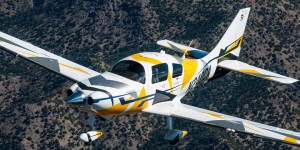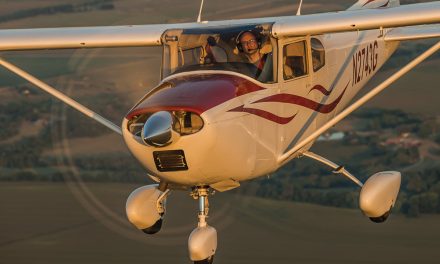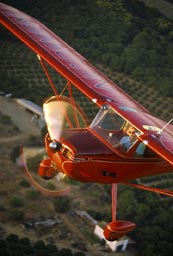Cessn a makes major upgrades to its Corvalis low-wing, composite single.
a makes major upgrades to its Corvalis low-wing, composite single.
Back in the ‘80s when I was working on the ABC TV show, “Wide World of Flying,” I flew up to Washington State to interview Ken Wheeler, designer of the Wheeler Express homebuilt, and fly his innovative airplane. In those days (1987?), the Wheeler Express was that rare machine—a four-seat homebuilt.
Like so many other homebuilt designs of the time, it was also a fixed-gear, composite airplane, nevertheless possessed of near-retractable performance. Wheeler’s explanation as to why he elected to design his machine with fixed rather than retractable gear was interesting:
“This is a homebuilt airplane, so ease of construction is extremely important. Fixed gear is simpler, lighter, and in many ways, stronger; plus it doesn’t compromise the fuel tank location. Whether you’re designing a homebuilt or certified airplane, retracting the wheels is almost universally more trouble than it’s worth. For most airplanes, this one included, it just makes more sense to leave the wheels hanging than retract them.”
Lance Neibauer of Lancair apparently felt the same way when he configured his first certified airplane, the Columbia 300. Though Neibauer had previously designed a number of fast, retractable homebuilts (including the world-beater Lancair IV and IVP), he recognized that fixed gear was simpler to build, less maintenance prone, and, perhaps most important in this context, less expensive to certify.
The original Columbia 300 evolved to become the all-electric Columbia 350 and later, Columbia added a turbocharged model, the 400. In 2007, the airplanes were rebadged as the Cessna Corvalis 350 and the top-of-the-line Cessna Corvalis 400TT. Since Cessna acquired the model line, its first low-wing, piston single ever, the company has made few substantive changes to the basic design, but a few modifications have improved the breed.
Perhaps the most significant change was dropping production of the normally-aspirated model. Cessna also addressed the airplane’s weight problem head-on. Three years ago, a new composite, single-bottle oxygen system was mounted in the tail, replacing the former, wing-mounted metal containers, and that recovered 25 pounds of payload. Buyers also have the option of deleting the formerly standard air conditioning system for a credit and another significant improvement in useful load, about 75 pounds. That’s a total payload increase of 100 pounds over the old airplane.
A new, cold weather kit improved engine oil temperatures for pilots operating the aircraft in frigid climates. For those same folks, Cessna certified an inadvertent TKS anti-ice system on the TTx. Rosen sun visors are now standard equipment. Finally, every Cessna Corvalis TTx comes with five hours of flight training to bring new owners up-to-speed on the airplane’s systems.
Of course, the big news is that the TTx offers cruise performance more appropriate to a retractable than a fixed gear airplane.
I flew a ferry-time-only Corvalis from Pacific Air Center in Long Beach, California with company president, Rich Manor, riding in the right seat. Manor commented that the new Corvalis line is proving popular with Cessna buyers in Southern California.
Manor explained that the new airplane filled a gap in Cessna’s product line and expanded the company’s horizons in a big way. “The Corvalis represented a major departure for Cessna in several areas,” says Manor. “Not only is it a low-wing airplane, it’s an all-composite design with gullwing doors and a side stick.
“Before advent of the Corvalis models, we really didn’t have any entry in the luxury, high-performance, single class,” Manor comments. “For that reason, we typically couldn’t even talk to pilots interested in a technologically-advanced four-seater. Practically everyone recognizes the Turbo Skylane as an excellent airplane, but it was never intended to compete with the Cirrus and Mooney. The Corvalis models put us back in the game.”
In spades! By any measure, the TTx is one of the strongest performers in the class. It features a turbocharged, 310-hp, Continental TSIO-550, the same basic engine that powers the Cirrus SR-22G3, Mooney Ovation III, and Acclaim S. The turbocharged Corvalis is an airplane that’s obviously serious about performance, sporting a slick, clean, composite finish as smooth as Murano glass. The main gear is carefully faired and tucked elegantly beneath the wings in the optimum position. In short, there’s very little hanging out to contribute drag and subtract speed.
Despite the improvements in the 2013 models, the TTx still suffers from a payload problem. That’s partially because the basic airplane isn’t “basic” at all. At 3600 pounds gross, it comes in full froth, with few options even available (though, as mentioned above, you can delete air conditioning). Our test machine was a standard-equipped example. According to Cessna, empty weight was 2600 pounds against a 3600-pound gross. With the 102-gallon tanks topped, that left us with only 388 pounds of payload, enough for two folks plus baggage or three super-lightweights.
Lack of payload is a common complaint among pilots of high-performance singles, but it’s not always a critical one. Many pilots who buy airplanes in this class know going in that the carry limit will be two full-sized folks plus baggage, and they’ve already made peace with that situation. (I’ve been flying a four-seat Mooney for 20 years, and I’ve filled the seats no more than a half-dozen times.)
Fortunately, most missions don’t demand full fuel and departing with 50 gallons in the TTx still provides two-and-a-half hour endurance, plus reserve. That allows for a 500-nm range, even at breathable altitudes, meanwhile boosting payload to a more salable 2 + 2 level.
If there’s any consolation for the low payload, it may be that the cabin is almost automotive in comfort. You step down off the wing and settle into the seat without some of the typical acrobatics of boarding other low wings. The gullwing doors fold up and out, ala Mercedes 300SL, and leather straps on each side help pull them back down to camlock in place.
Once you’re ensconced in the tuck-and-roll, Napa leather, front bucket seats, space is more akin to that of an Audi than a typical general aviation airplane. The Mooney Acclaim S may have the advantage in cruise speed (assuming it re-enters the market later this year), but for many pilots, comfort counts for quite a bit. The TTx scores better in cabin room, a 4’ x 4’ enclosure with plenty of elbow, hip, and legroom.
The Corvalis line features side sticks that are something of a mixed blessing. On the positive side, they open up the space directly in front of both pilots, allow ready access to all controls and switches, and improve crashworthiness. Conversely, roll response with the short throw is heavier than with the mechanical advantage of a yoke. In a similar sense, you can’t simply rest your forearm on the armrest and steer the airplane with a flick of your wrist as you might imagine. Control forces aren’t oppressive, but the airplane does demand some minor muscle in maneuvering.
From the moment you push the throttle forward for takeoff, it’s apparent the Corvalis has something extra under the hood. The big Continental pulls like a team of Clydesdales, devouring runway with almost automotive enthusiasm. Manifold pressure limit is 35.5 inches, and that’s adequate to maintain sea-level power all the way to the airplane’s max altitude of 25,000 feet.
Continental’s twin turbos manifest maximum effect by maintaining power as the airplane climbs above 5000 feet. Expect 1200-1300 fpm at gross, 1500 fpm when flying light. That means you can usually expect to see two-mile altitudes less than eight minutes after takeoff.
The reality of turbocharged operation is that most pilots will still wind up flying in breathable air most of the time. A turbocharger provides the flexibility to ascend to the mid-teens or even the low-20s flight levels if there’s a need, but most pilots prefer the bottom 12,000 feet of sky. The Cessna TTx’s quoted max cruise speed of 235 knots is certainly an attractive number, but if it’s attainable at all, it’s only at a fairly hostile 25,000 feet, pouring well over 24 gph through the engine.
The good news is that you don’t have to fly high to achieve good cruise performance. If you elect to ascend to the middle sky, the TTx still offers excellent speed under friendlier conditions.
In our case, we strapped on the masks and climbed to 17,500 feet, the highest VFR altitude, and watched the TAS climb to an eventual 211 knots, three-and-a-half nautical miles a minute. That’s more than half the speed of a typical VLJ at a quarter of the purchase price and probably a sixth of the operating cost.
Forget the 235 knot spec; even at 211 knots, you could easily transit the lower US in a single, long, workday with only one fuel stop. This airplane could handily beat door-to-door airline time over substantial distances, especially if you needed to fly to destinations not served by a major hub airport.
Fuel burn on our flight was about 18 gph at the max cruise setting so our fuel supply would have allowed four hours endurance, plus reserve—worth an easy 850 nm and then some. Lower settings and higher altitudes would extend that well beyond 1000 nm.
Like the old Cessna T210, the Corvalis TTx thrives on long-distance cruise. The airplane is stable as a table and loves to stretch out and fly to far horizons. Using reduced power settings, the Corvalis will log over 1000 nm at a sitting, about the same as a typical Mirage or T-Cirrus. With contoured seats, copious interior, and good soundproofing, the Corvalis should make a good platform for owner/operators.
Garmin’s new G2000 touch screen glass panel with G700 autopilot and Synthetic Vision is the latest avionics miracle, and the latter recreates the view ahead so accurately, you’d think you were peering through a forward-looking TV screen. In theory, you could fly a full zero/zero approach using Synthetic Vision. It’s that accurate. I flew the latest iteration of Garmin’s Synthetic Vision recently in conjunction with the Sun ‘n Fun Airshow, and the artificial depiction of the topography and lakes around Lakeland, Florida, was almost so precise, it was missing only the real-time boat wakes!
The Cessna Corvalis TTx joins the Cirrus SR-22G3 Turbo for top fixed-gear honors among the big-cabin four-seaters. Mooney is a question mark, though we’re all hoping that Chinese money will help return the lovable little retractable to competition. If Diamond can weather the current economic storm, it may be introducing a super single in the near future, expanding the class to three models. Though Dale Klapmeier of Cirrus steadfastly refuses to join in a full-fledged speed race, it should be fun to watch the sales competition between four of general aviation’s most successful companies.
Specifications & Performance – Cessna Corvalis TTX
All specs and performance numbers are drawn from official sources, often the aircraft flight manual or the manufacturer’s web site. On used aircraft, common sources of information are Jane’s All-The-World’s Aircraft or RVI’s Aircraft Bluebook Price Digest.
Specifications
Used Price: $733,500
Engine make/model: Continental TSIO-550C
Horsepower at altitude: 310 @ SL to 25,000 ft.
Horsepower on takeoff: 310
TBO – hours: 2000
Fuel type: 100LL
Propeller: Hartzell CS
Landing gear type: Tri/Fxd
Gross weight (lbs): 3600
Std empty weight (lbs): 2600
Useful load – std (lbs): 1000
Usable fuel – std (gal/lbs): 102/612
Payload – full std fuel (lbs): 388
Wingspan: 35’ 10”
Overall length: 25’ 4”
Height: 9’
Wing area (sq. ft.): 141
Wing loading (lbs/sq. ft.): 25.5
Power loading (lbs/hp): 12.3
Wheel size: 6.00 x 6
Seating capacity: 4
Cabin doors: 2
Cabin width (in): 48
Cabin height (in): 49
Performance
Cruise speed (kts): 75% 222
Fuel Consumption (gph): 75% 19.5
Best rate of climb, SL (fpm): 1400
Maximum Operating Altitude (ft.): 25,000
Stall – Vso (kts): 59
TO over 50 ft. (ft.): 1900
Ldg over 50 ft. (ft.): 2600





